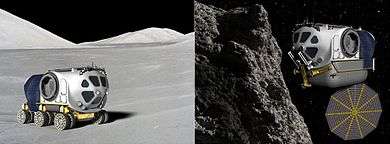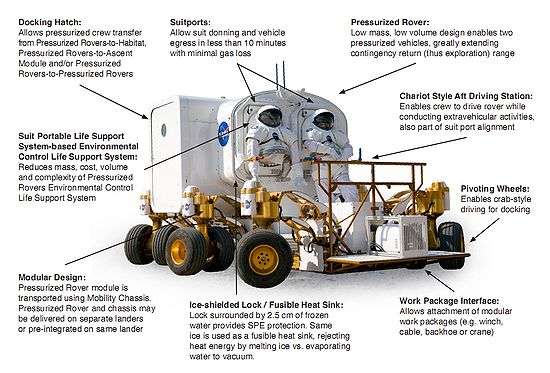Space Exploration Vehicle


The Space Exploration Vehicle (SEV) is a modular multi-mission vehicle concept developed by NASA. It would consist of a pressurized cabin that can be mated either with a wheeled chassis to form a rover for planetary surface exploration (on the Moon and elsewhere) or to a flying platform for open space missions such as servicing satellites and missions to near-Earth asteroids.[1] The concept evolved from the Lunar Electric Rover (LER) concept, which in turn was a development of the Small Pressurized Rover (SPR) concept.[2]
Concept vehicles of the Lunar Electric Rover (and later, the SEV) were tested during the Desert Research and Technology Studies in 2008,[2] 2009,[3] 2010[4] and 2011.[5][6][7] One of the LER concept vehicles took part in the presidential inauguration parade of Barack Obama in 2009. Research and testing continued in 2012 in the Johnson Space Center with a mock-up of a free-flying SEV simulating a mission to an asteroid.[8]
Development of the SEV has continued, producing variants called the Multi-Mission Space Exploration Vehicle (MMSEV) and in 2013 a cabin for a possible lunar lander called the Alternate MMSEV (AMMSEV).[9]
The SEV is developed together with other projects under the Advanced Explorations Systems Program. The program's budget for FY 2010 was $152.9 million.[10]
Features
The SEV is the size of a small pickup truck, it has 12 wheels, and can house two astronauts for up to two weeks.[11] The SEV consists of a chassis and cabin module.[12] The SEV will allow the attachment of tools such as cranes, cable reels, backhoes and winches.[12] Designed for 2, this vehicle is capable of supporting 4 in an emergency.[12] With wheels that can pivot 360 degrees, the SEV is able to drive in any direction.[12] Astronauts can enter and exit without space suits directly from an airlock docking hatch, or through a suitport without the need to depressurize the habitat module.[12]
The pressurized module contains a small bathroom with privacy curtains and a shower head producing a water mist for sponge baths.[13] It also contains cabinets for tools, workbench areas and two crew seats that can fold back into beds.[13]
Specifications

- Speed: 19 km/h (12 mph)
- Range: 125 km (78 mi)
SEV
- Mass: 3,000 kg (6,614 lb)
- Payload: 1,000 kg (2,205 lb)
- Length: 4.5 m (180 in)
- Wheelbase: 4 m (160 in)
- Height: 3 m (120 in)
- Wheels: 12 cm (4.7 in) x 99 cm (39 in) in diameter, 30 cm (12 in) wide
Chassis
- Mass: 1,000 kg (2,205 lb)
- Payload: 3,000 kg (6,614 lb)
- Length: 4.5 m (180 in)
- Wheelbase: 4 m (160 in)
- Height: 1.3 m (51 in)
- Wheels: 12 cm (4.7 in) x 99 cm (39 in) in diameter, 30.5 cm (12.0 in) wide
References
- ↑ NASA's Space Exploration Vehicle (SEV)
- 1 2 "Three Days in the Desert Tests Lunar "RV"". NASA. December 3, 2008.
- ↑ "Desert RATS 2009 14-Day Analog Mission". NASA. November 8, 2010.
- ↑ "Desert RATS 2010 Complete 13th Annual Field Test". NASA. April 8, 2011.
- ↑ "Desert RATS 2011". NASA. July 8, 2011.
- ↑ "Desert RATS 2011: Wrap-up Report". NASA. September 26, 2011.
- ↑ "D-RATS Set Sights on Asteroid". NASA. September 30, 2011.
- ↑ "2012 Research and Technology Studies Resume at JSC". NASA. January 18, 2012.
- ↑ Howard, Jr., Robert L. (January 22, 2014). "An Alternate Configuration of the Multi-Mission Space Exploration Vehicle" (PDF). NASA. JSC-CN-30087.
- ↑ "NASA's Budget: Advanced Explorations Systems Program".
- ↑ "NASA's New Lunar Electric Rover (LER)". NASA. Retrieved 2009-09-29.
- 1 2 3 4 5 "Lunar Electric Rover Concept" (PDF). NASA. Retrieved 2009-09-29.
- 1 2 "How Lunar Rovers Work". howstuffworks. Retrieved 2009-09-29.
External links
| Wikimedia Commons has media related to Space Exploration Vehicle. |